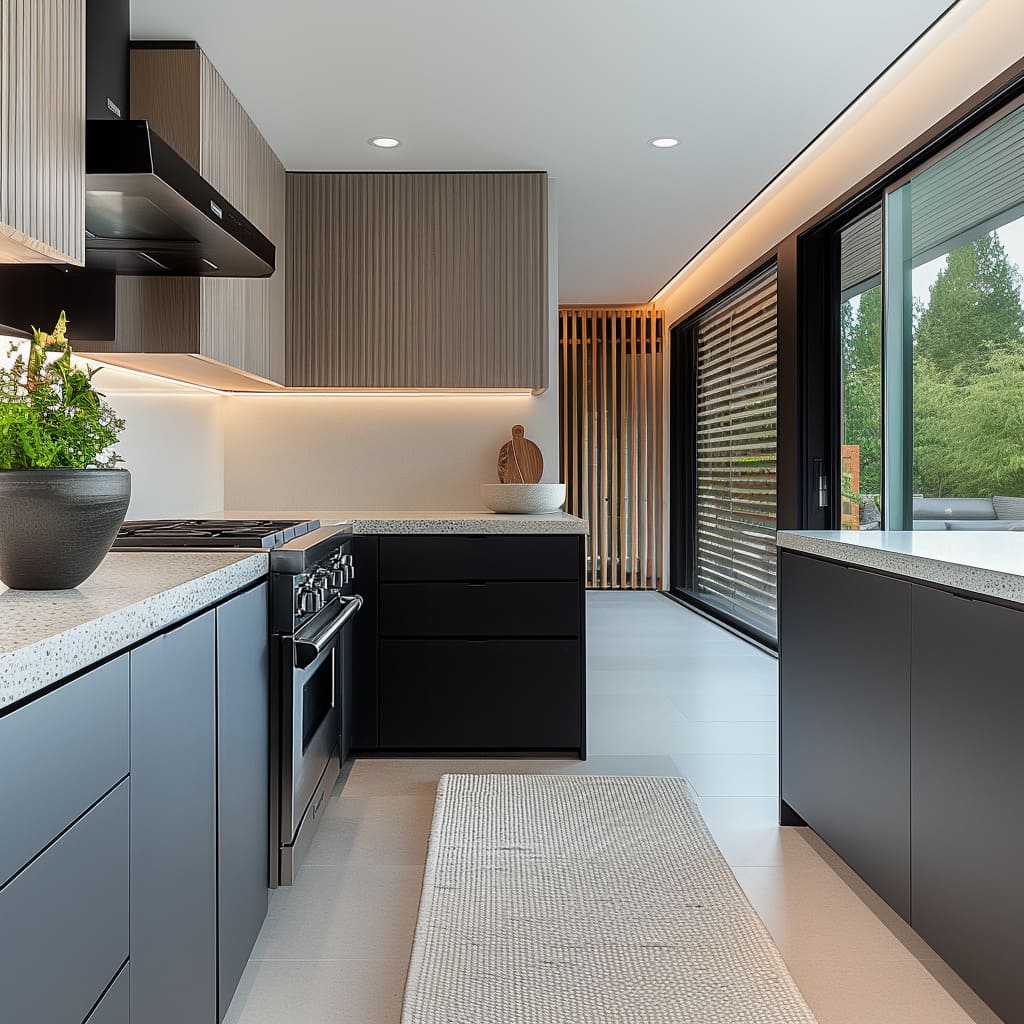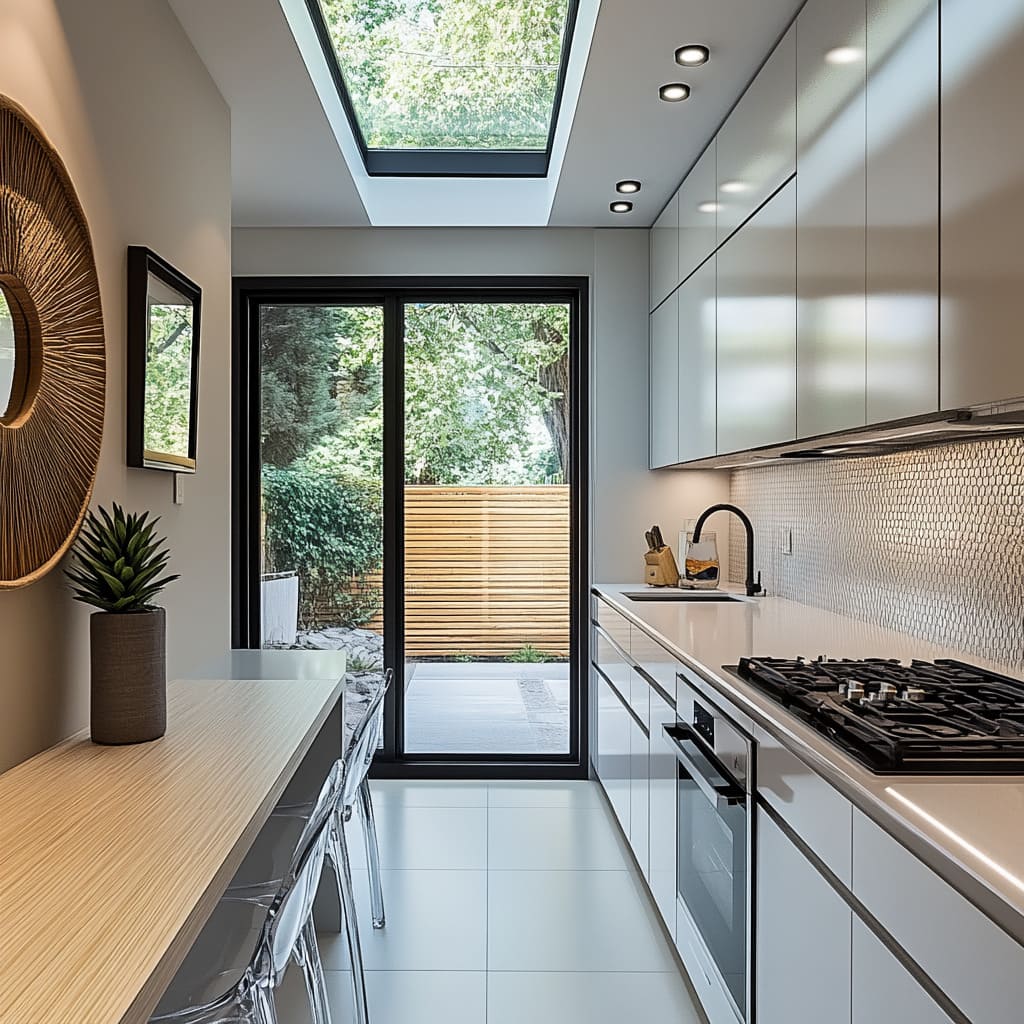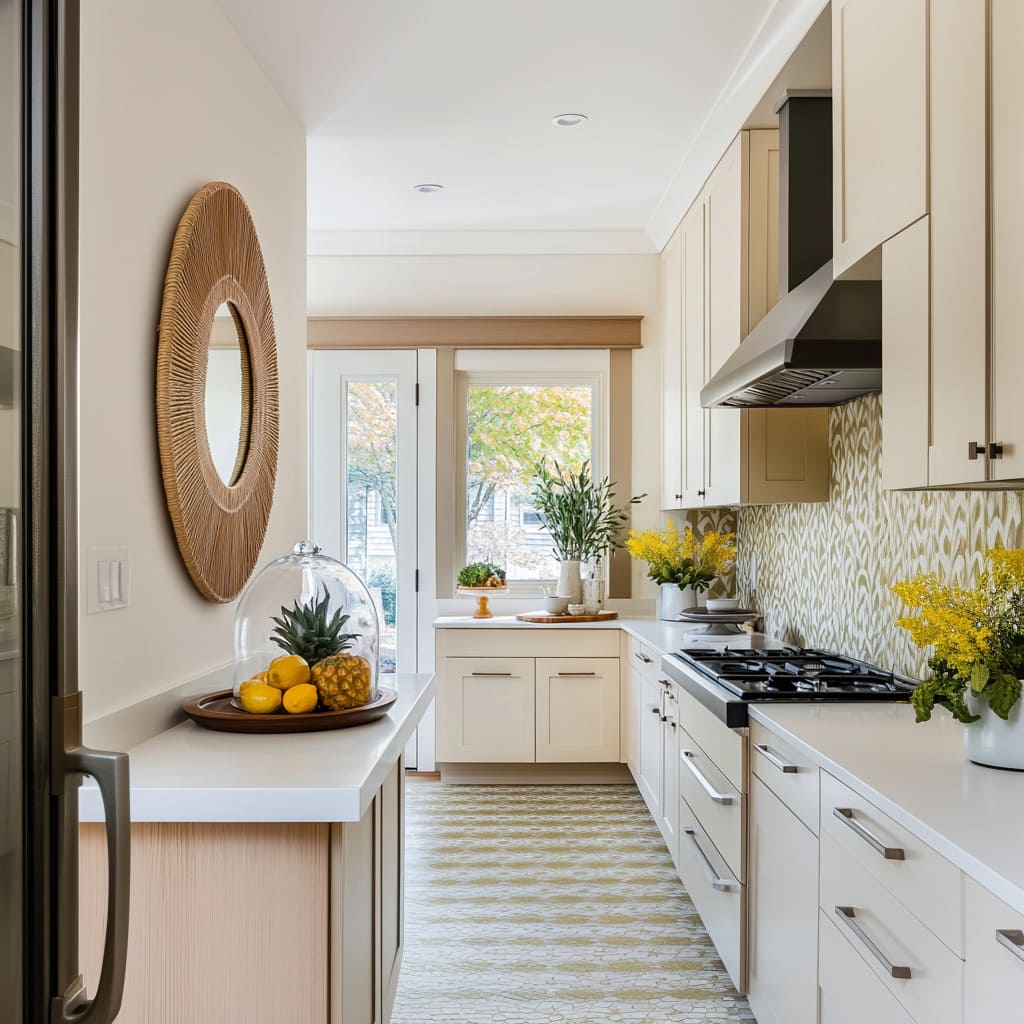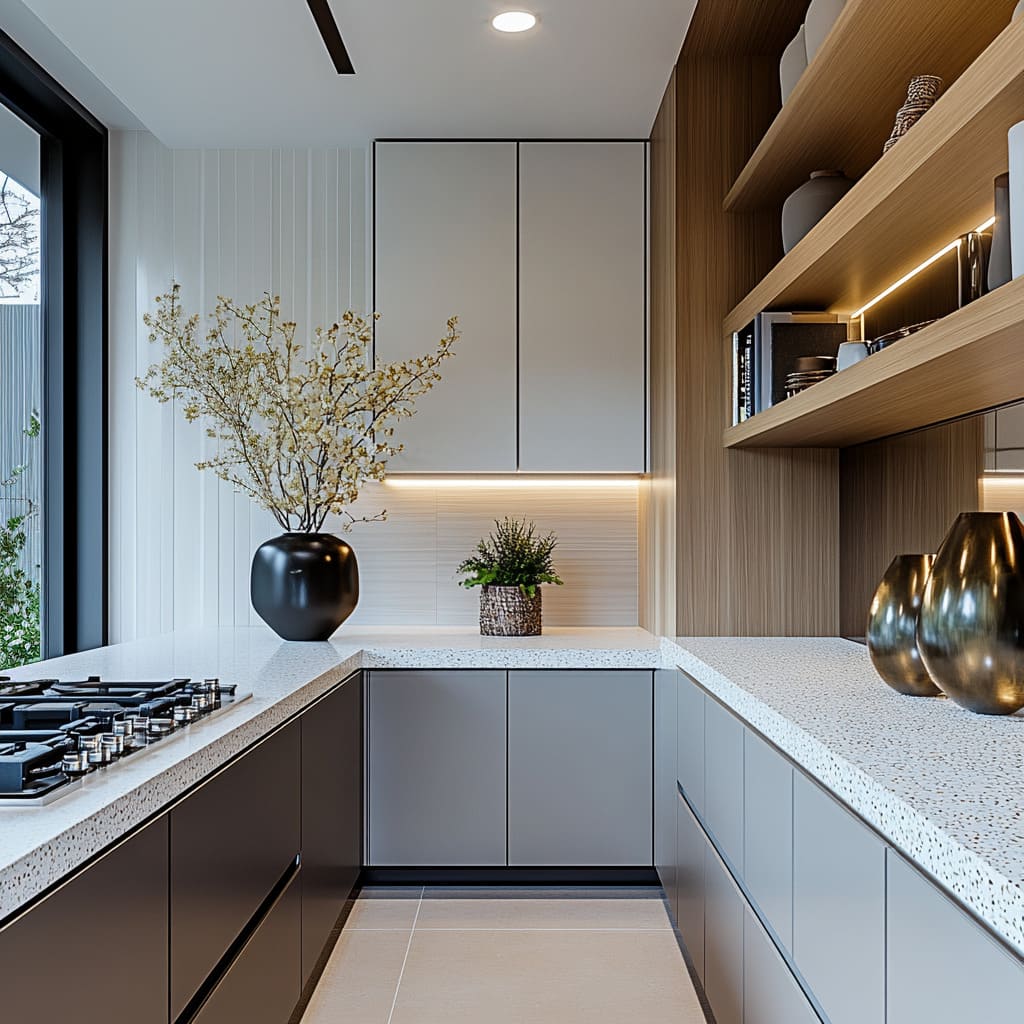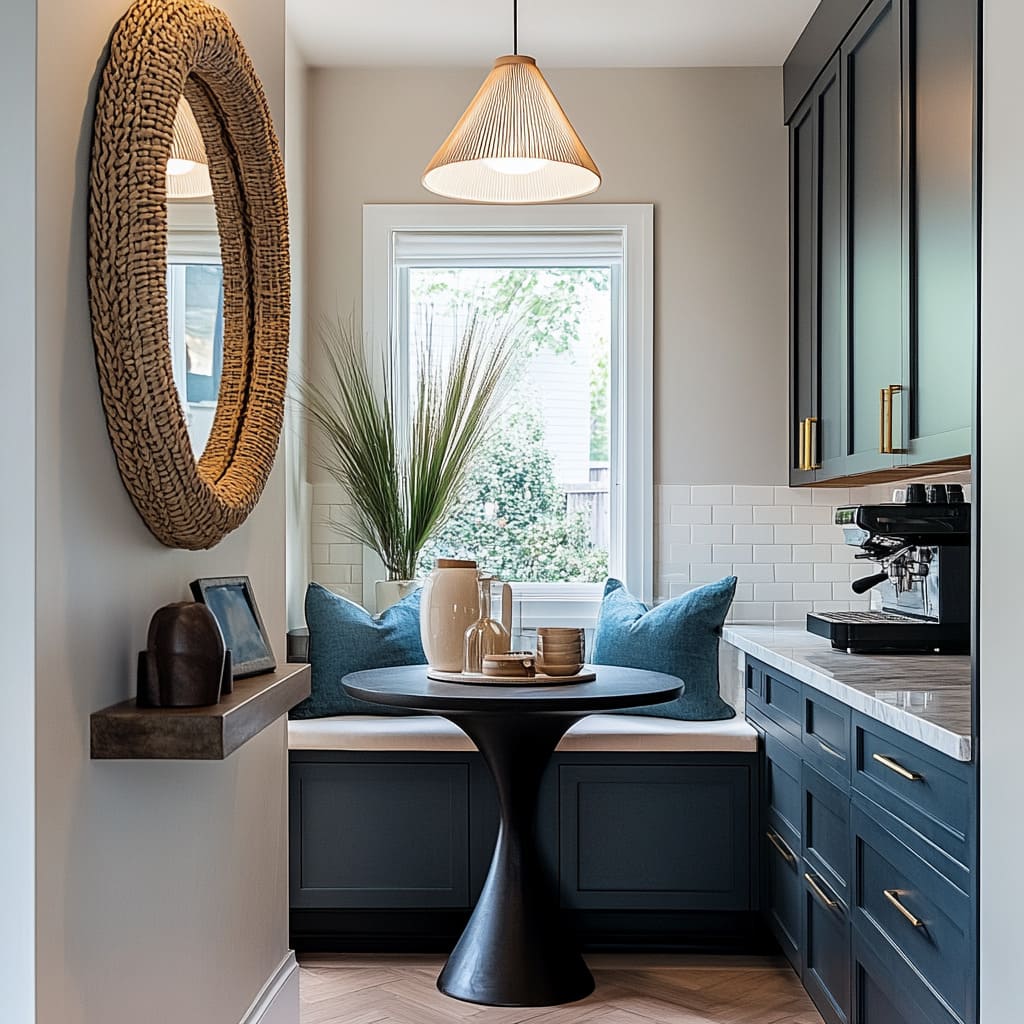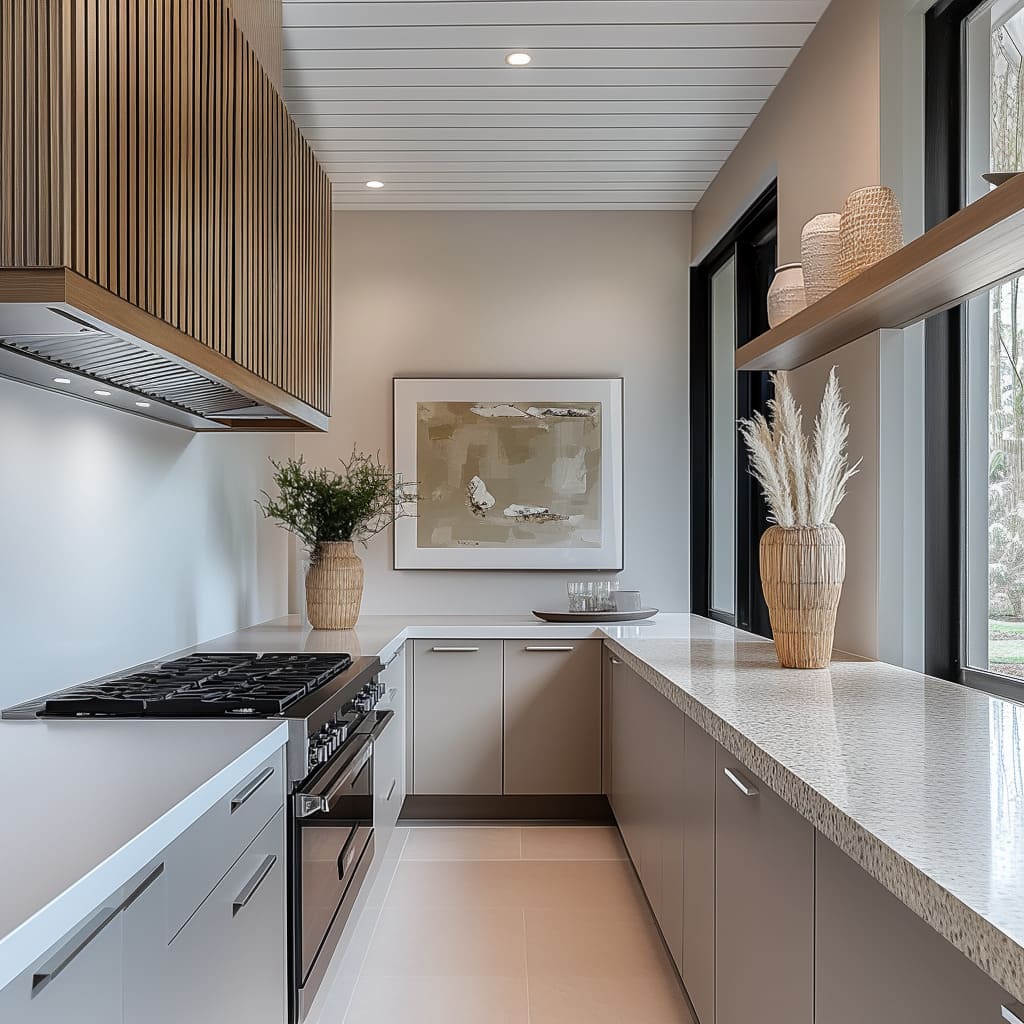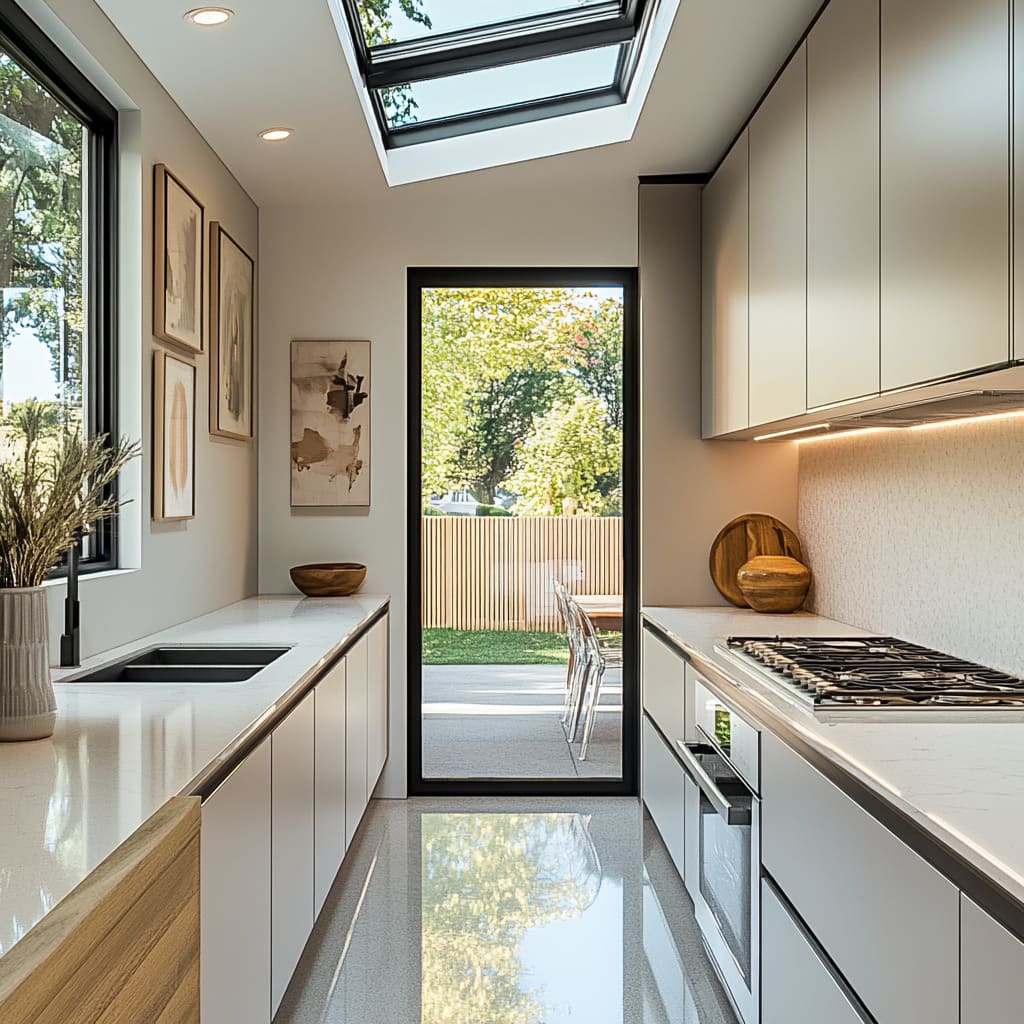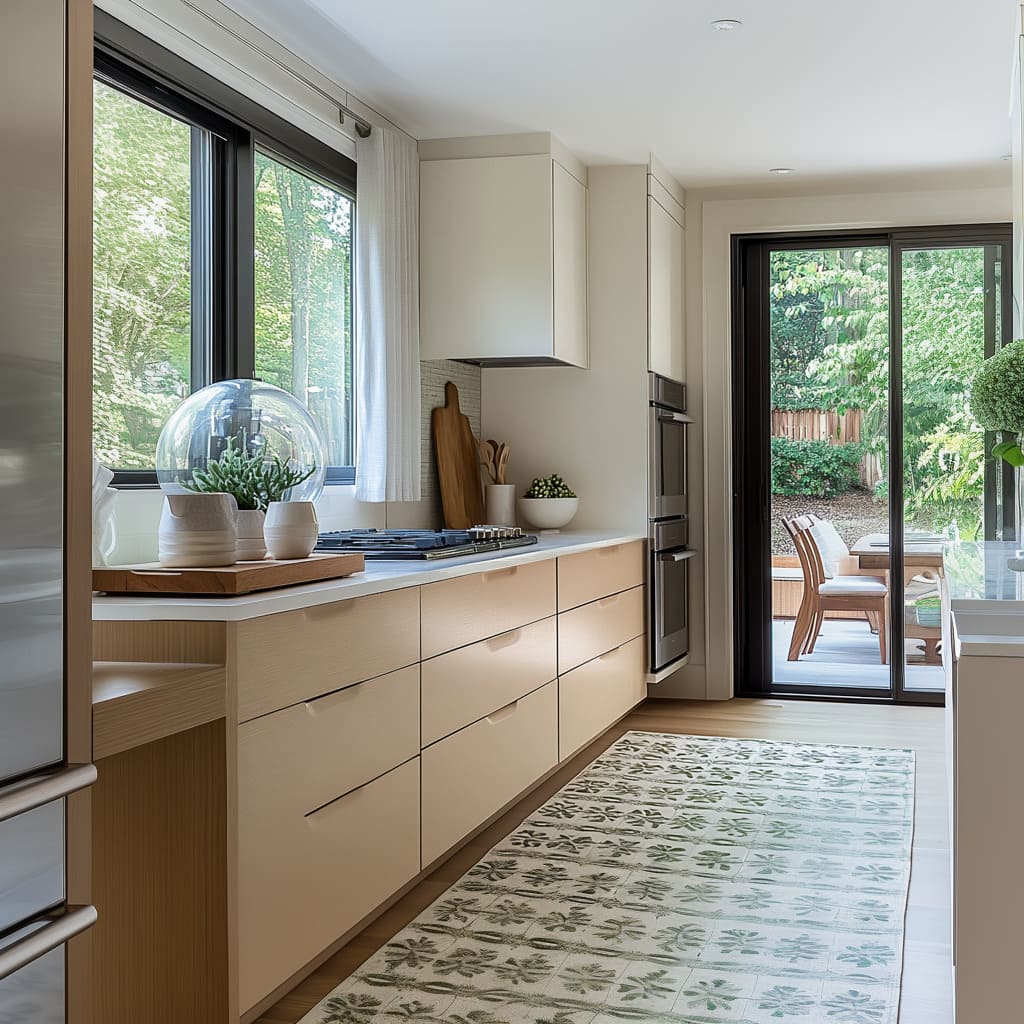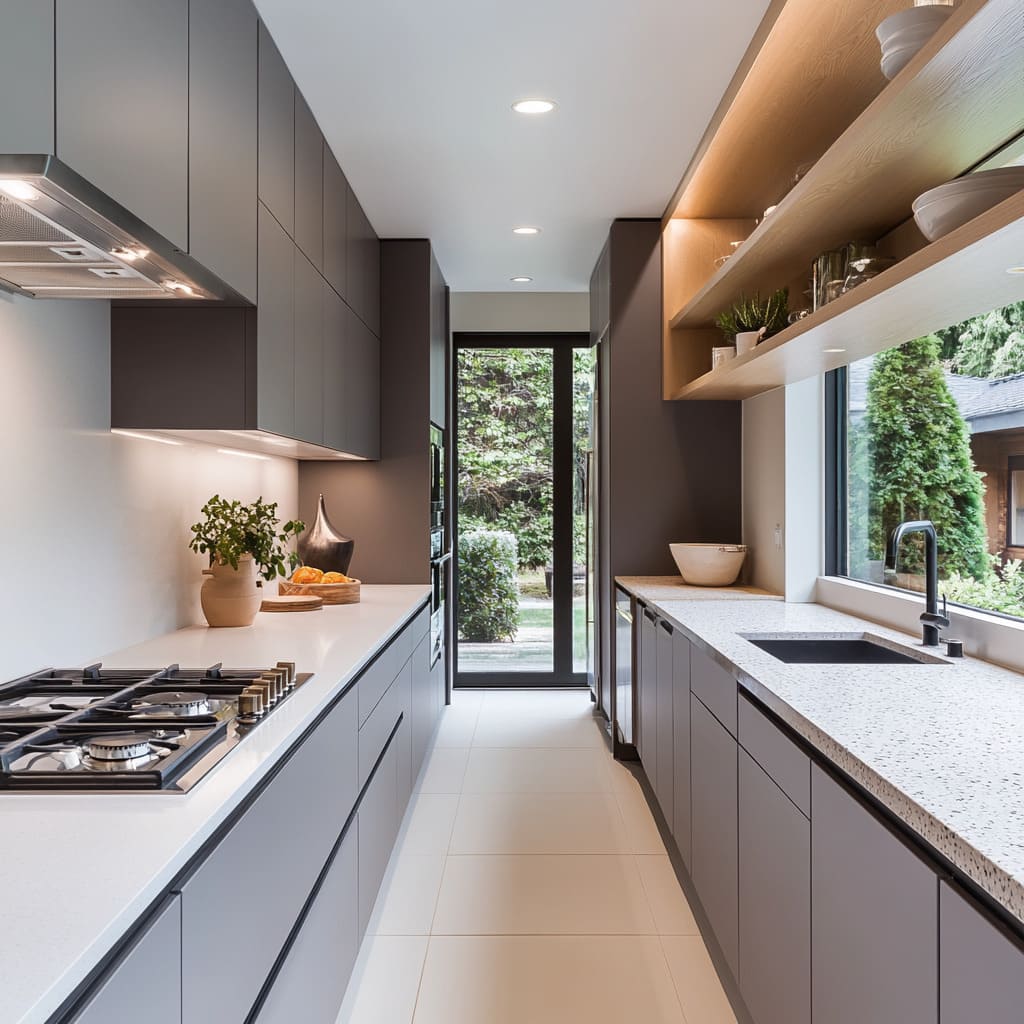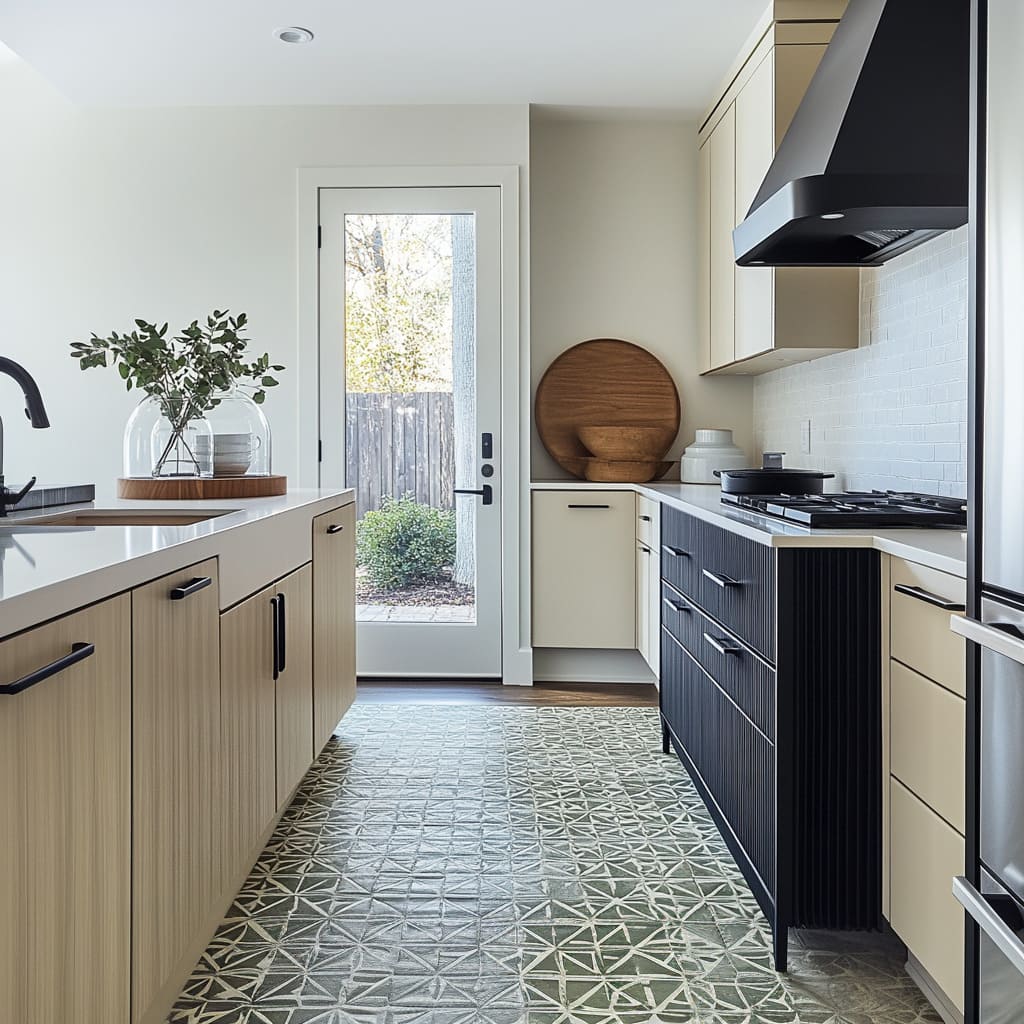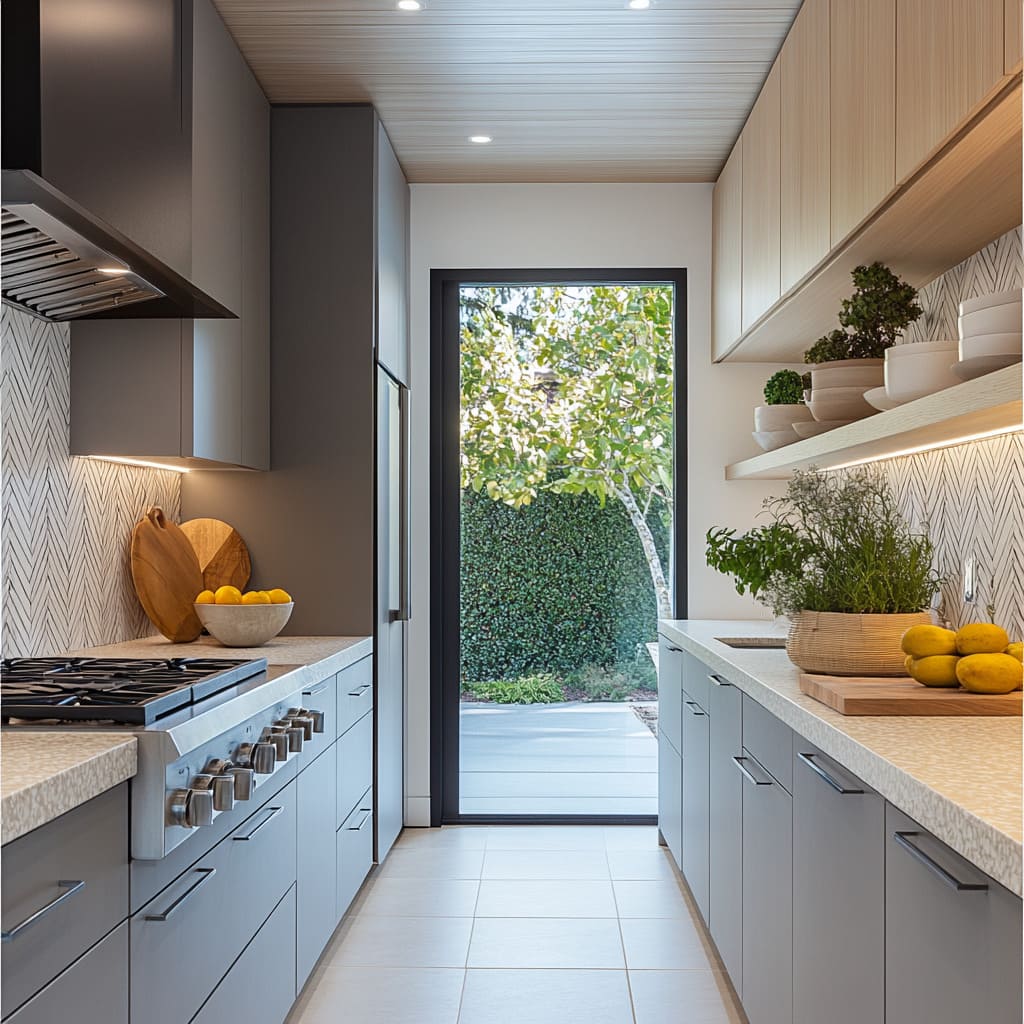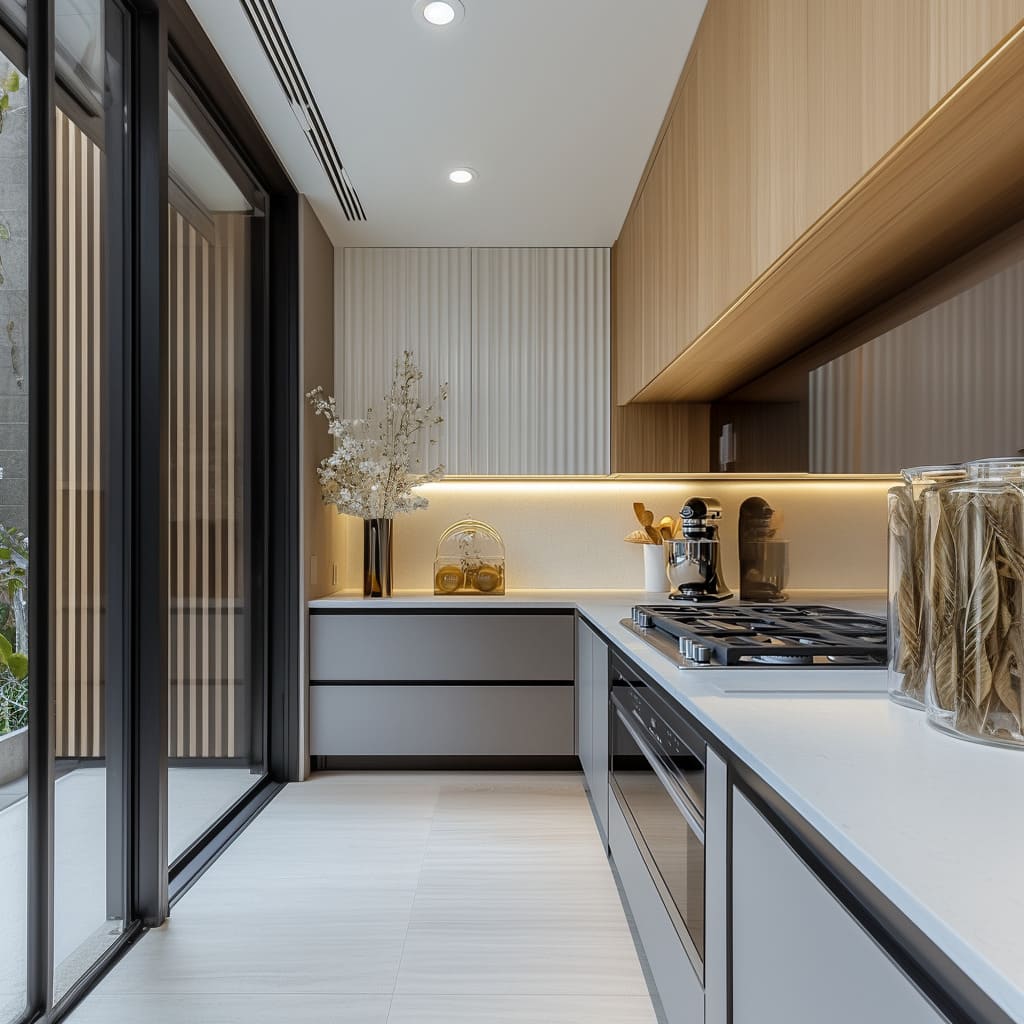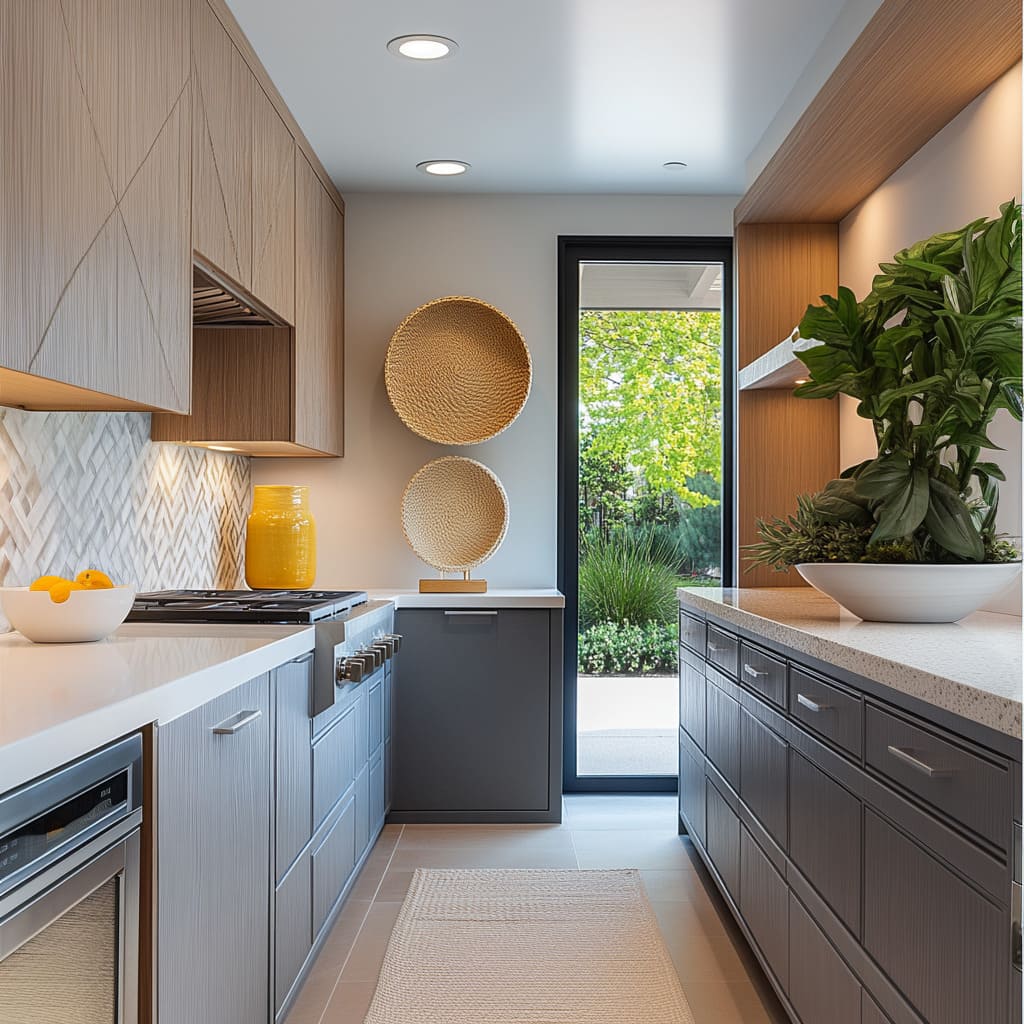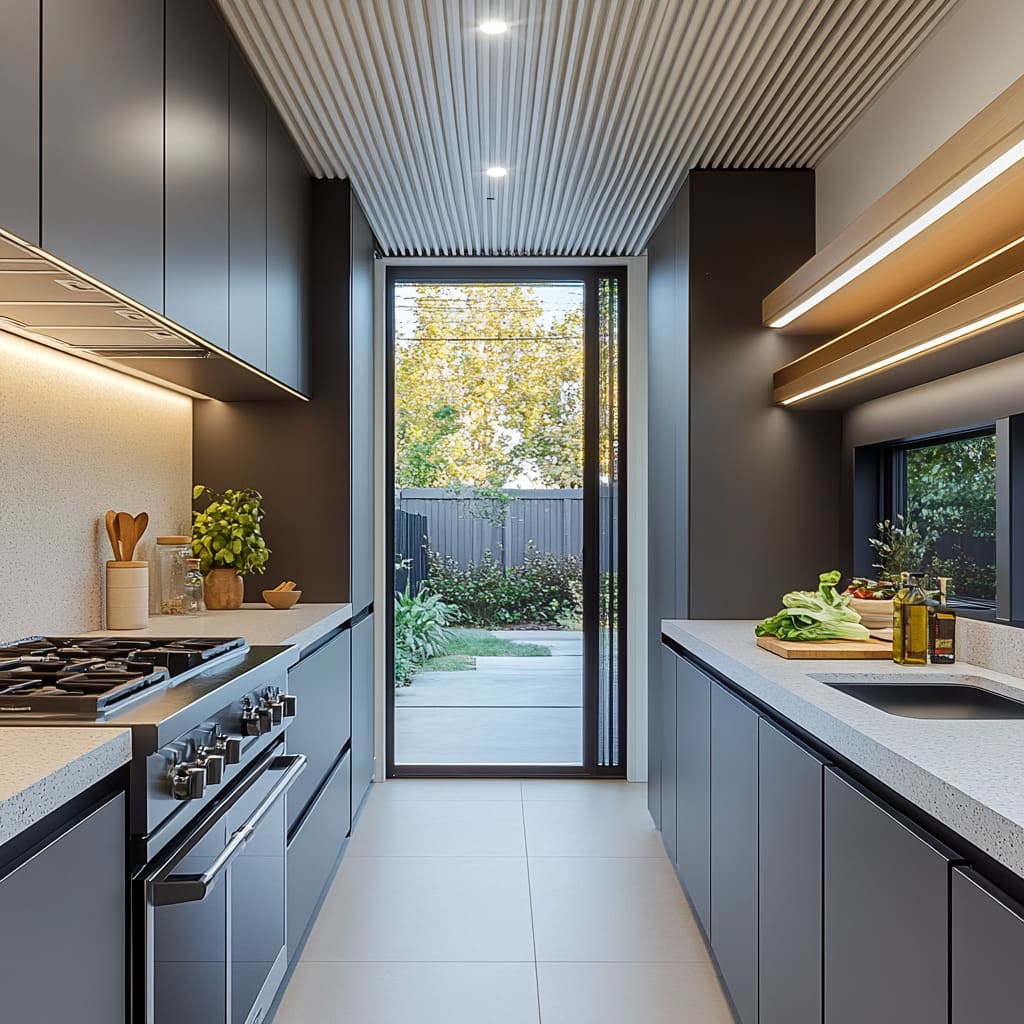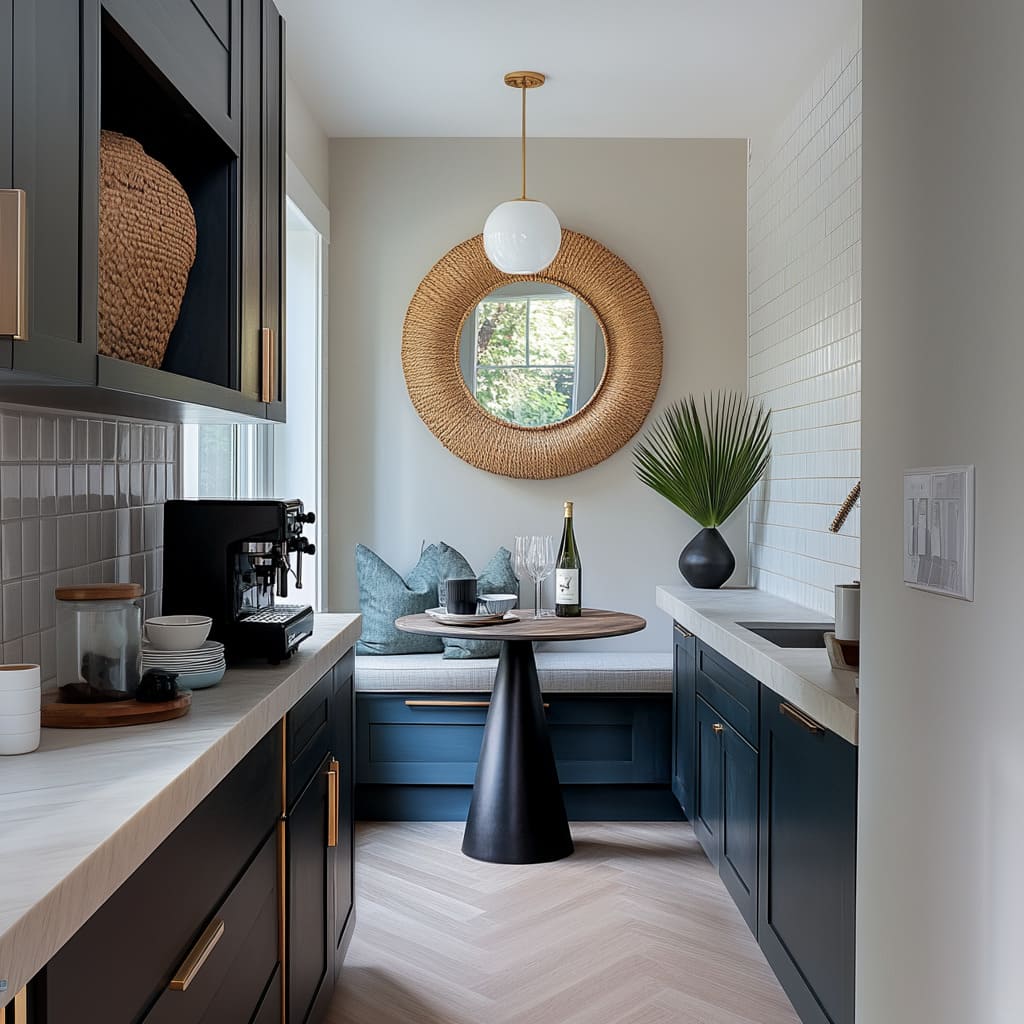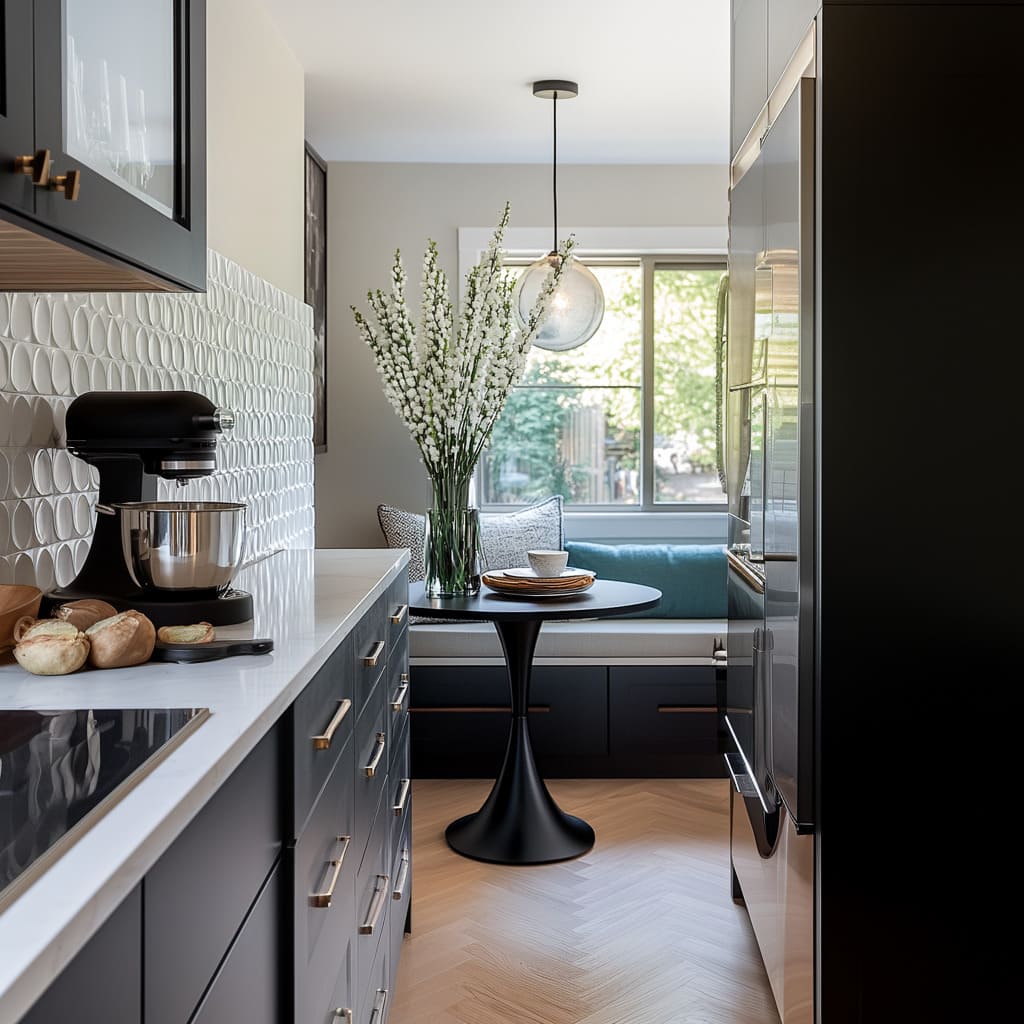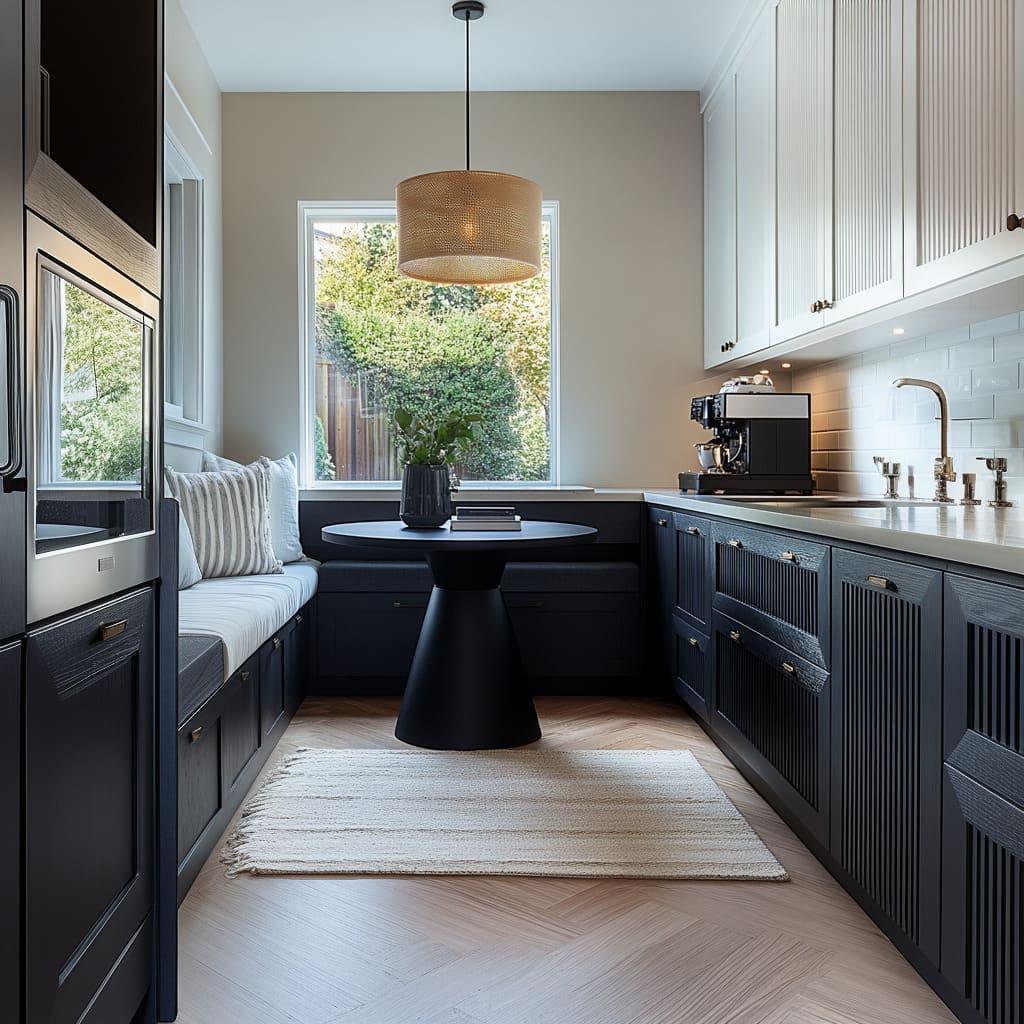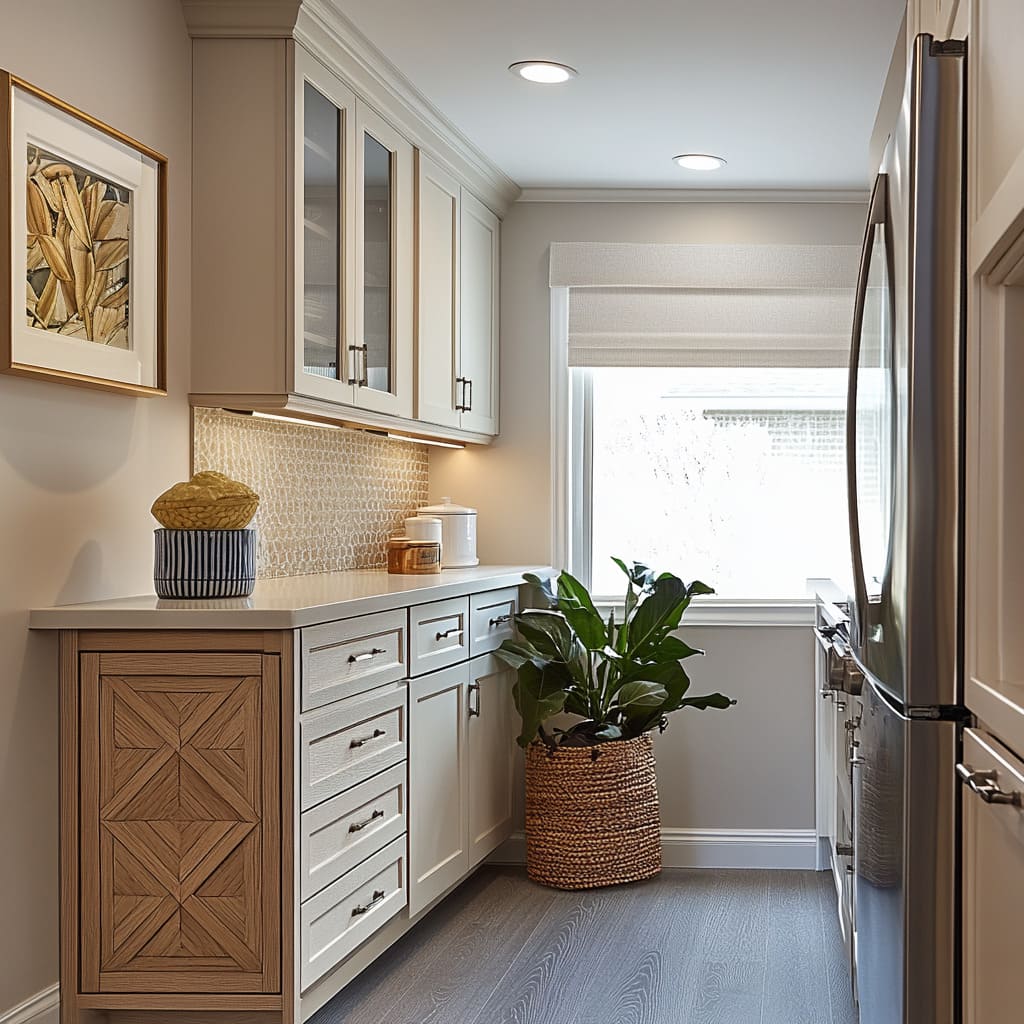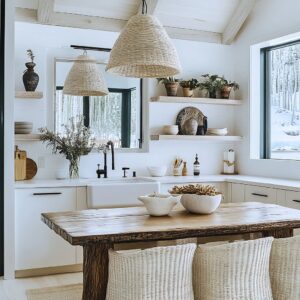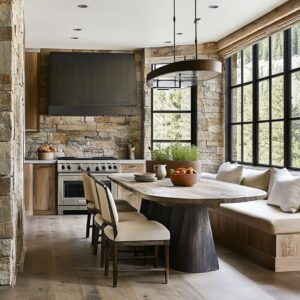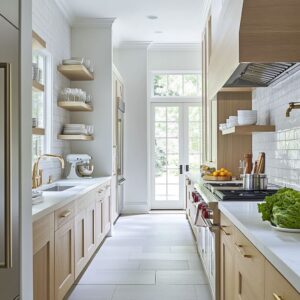When it comes to blending style and efficiency, the modern galley kitchen proves its worth in homes where every square foot counts. This layout is not only a practical choice but also a canvas for creativity, offering a range of possibilities that make it stand out.
By prioritizing clever use of space, thoughtful material combinations, and functional features, this design has become a favorite for homeowners who value both utility and aesthetic appeal. One of the standout features of modern galley kitchens is their ability to turn what might seem like a narrow or constrained space into a highly organized and visually appealing area.
By placing cabinets, appliances, and countertops along parallel walls, the design creates an intuitive workflow. This ensures that essential tasks—whether cooking, prepping, or cleaning—are all within easy reach.
This layout makes the most of compact spaces, an especially valuable trait in urban homes or older properties with tighter floor plans.
Another key advantage of this style lies in its ability to adapt to personal tastes. Modern galley kitchen ideas often feature a combination of light and dark finishes to create depth and visual balance.
For example, pairing dark lower cabinetry with lighter upper cabinets can make the space feel taller and more open. Incorporating natural wood tones or textured finishes adds warmth, while sleek, minimalistic hardware maintains a clean and polished look.
These choices work together to give the kitchen a contemporary edge without overwhelming the senses. Lighting is another critical aspect that transforms galley kitchens from purely functional to inviting.
Recessed lights, under-cabinet LEDs, and pendant fixtures not only illuminate workspaces but also highlight design elements like textured backsplashes or carefully curated open shelving. Strategic lighting enhances the flow of the kitchen and ensures that no corner feels neglected, even in narrow layouts.
Incorporating natural materials and thoughtful details can make a galley kitchen feel connected to the rest of the home. Elements such as wood-paneled cabinetry, ceramic accents, or live greenery help to soften the sharp lines of modern designs.
This balance of form and material ensures that the space is not just visually pleasing but also comfortable and welcoming. Ultimately, a modern galley kitchen thrives on its ability to provide everything you need without unnecessary excess.
It’s about maximizing functionality while ensuring every design choice adds to the room’s character. For those who value a combination of practicality and style, this layout offers an opportunity to create a kitchen that doesn’t just work—it stands out as a central feature of the home.
Whether you’re working with a small city kitchen or reimagining the layout of a classic suburban home, this approach has a timeless appeal that’s both smart and stylish.
Key Elements
- Contrast in Finishes: Dual-tone cabinetry and contrasting materials help define zones within the galley kitchen.
- Flooring as a Feature: Patterned or textured flooring is a practical yet stylish way to elevate narrow spaces.
- Blending Storage Types: Open shelving combined with closed cabinets ensures both functionality and aesthetic flexibility.
- Natural and Organic Accents: Wooden elements, greenery, and woven textures soften modern designs and connect the space to the outdoors.
- Focus on Verticality: Tall cabinetry, paneling, and elongated tiles create height and expand the space visually.
- Dynamic Lighting: Layered lighting enhances both functionality and ambiance while highlighting key design features.
Balance of Contrasts: The Role of Light and Dark Tones
In contemporary galley kitchen design, the art of contrast plays a transformative role. By carefully blending light and dark tones, these kitchens create a sense of depth and balance, even in narrow spaces.
This strategy goes beyond aesthetics; it enhances functionality and makes the kitchen feel more dynamic and spacious. One of the most impactful ways this balance is achieved is through cabinetry.
Dark-toned cabinets, such as matte black or rich navy, exude sophistication and anchor the space. To avoid a sense of heaviness, these are often paired with lighter countertops or backsplashes.
The reflective quality of materials like quartz or subway tile helps distribute light, making the kitchen feel open and welcoming. Conversely, kitchens with lighter cabinetry take on a fresh, airy look when complemented by bold accents, such as dark hardware or a statement floor.
The interplay of light and dark is especially effective in defining specific zones within the kitchen. For example, light upper cabinets paired with darker lower ones create a vertical transition that draws the eye upward, enhancing the room’s perceived height.
This technique is particularly useful in galley kitchens, where maximizing every visual element is key to avoiding a cramped feel. Beyond cabinetry, flooring and walls also contribute to this contrast.
Patterned tiles with a mix of light and dark shades add subtle character underfoot, while darker wall finishes can frame the space without overwhelming it. The overall effect is a kitchen that feels cohesive yet multidimensional, combining utility with striking visual appeal.
Lighting further amplifies the benefits of contrast. Under-cabinet lighting enhances the brightness of lighter surfaces, while strategically placed overhead fixtures emphasize the depth of darker elements.
This layering of light ensures that every feature, from a sleek backsplash to bold cabinetry, gets its moment to shine. For homeowners looking to implement this balance, a thoughtful approach to materials and colors is essential.
Incorporating dual-tone cabinetry, such as light wood for upper sections and dark slatted finishes for lower ones, creates a harmonious yet intriguing visual flow. Paired with carefully chosen accents like brushed metal hardware or textured backsplashes, this design approach elevates the kitchen while maintaining its practicality.
Ultimately, contrast in galley kitchens is about more than just aesthetics; it’s about creating a space that feels balanced, purposeful, and tailored to modern living needs. By blending light and dark tones thoughtfully, these kitchens make a bold statement while maximizing functionality, proving that even small spaces can have a big impact.
Functional and Decorative Flooring Choices
Flooring often takes a backseat in kitchen design discussions, but in galley kitchens, it holds immense potential to shape the overall aesthetic and functionality of the space. The kitchens featured in this analysis underscore how the right flooring choices can elevate even narrow layouts, offering both a visual statement and practical benefits.
Patterned tiles emerge as a recurring favorite for galley kitchen remodel ideas, providing an avenue for creativity and individuality. Geometric and botanical motifs are particularly effective in defining the space without overpowering it.
These patterns introduce subtle movement underfoot, drawing attention to the length of the kitchen while avoiding the risk of visual clutter. The muted tones often chosen for these tiles help maintain harmony with other elements, such as cabinetry and countertops.
The linear layout of galley kitchens makes the floor a natural canvas for design. When vertical surfaces like walls and cabinetry are kept minimal, flooring becomes a secondary focal point, offering a chance to introduce personality.
Bold flooring patterns help balance simplicity in other areas, creating an understated yet cohesive look that feels intentional and curated. It’s an opportunity to inject character without overloading the narrow space with excessive detailing.
Durability is a key consideration for any kitchen floor, but it’s particularly critical in high-traffic galley kitchens. Porcelain and ceramic tiles are popular choices not just for their durability but also for their ability to retain intricate patterns.
These materials are practical for everyday wear and tear while maintaining their aesthetic appeal over time. For homeowners who prefer softer options, patterned runners or rugs can serve as an excellent alternative, offering both comfort and a visual break in work zones.
The alignment and size of flooring patterns are equally significant. Larger tiles with oversized patterns help to visually expand the space, making the kitchen feel less confined.
Meanwhile, narrower tiles or herringbone arrangements emphasize the linear nature of the layout, accentuating the kitchen’s length. In both cases, careful consideration of proportions ensures the flooring complements the overall design rather than competing with it.
For homeowners seeking a layered look, combining flooring with subtle accessories can further enhance the space. A neutral tile floor can be paired with textured mats or small area rugs near the sink or prep areas to soften the design while adding comfort.
This balance of practicality and style ensures that the kitchen remains a welcoming and functional space. Ultimately, flooring in a galley kitchen is much more than a surface—it’s an integral design element that ties the entire space together.
Whether opting for bold patterned tiles, natural wood tones, or carefully placed rugs, the floor has the potential to ground the design and amplify the kitchen’s personality. By focusing on materials, patterns, and layout, homeowners can transform their galley kitchens into spaces that are as visually striking as they are practical.
Integration of Open and Closed Storage
Modern galley kitchen design has redefined how storage functions in compact spaces, striking a balance between accessibility and aesthetics. By combining open shelving with closed cabinetry, these kitchens achieve a harmonious blend of functionality and personalization.
This thoughtful storage integration not only optimizes space but also adds visual interest, giving homeowners the flexibility to showcase their style while maintaining practicality. Open shelving serves as a versatile design element, offering a space to display curated decorative items such as ceramic dishes, glassware, potted plants, or vases.
These carefully chosen pieces bring character to the kitchen and create a connection with the surrounding decor. However, to avoid overwhelming the visual space, open shelving is often used sparingly, reserved for key areas like corners, above counters, or near windows.
When bathed in natural light, these open displays transform into striking focal points that draw the eye and enhance the sense of openness. In contrast, closed cabinetry ensures that less visually appealing essentials—like pots, pans, or pantry items—remain tucked away.
This combination prevents the kitchen from feeling cluttered or chaotic, especially in narrow galley layouts where every inch matters. Closed cabinets also create a sleek, cohesive look that anchors the design, acting as a backdrop against which the open shelving can shine.
Pairing these two storage styles keeps the kitchen functional without sacrificing its aesthetic appeal. The placement and design of the storage play a significant role in how the space is perceived.
Open shelving placed near windows or corners not only benefits from natural light but also breaks up the monotony of continuous cabinetry. This strategic placement reduces the visual weight of the storage and gives the kitchen a lighter, airier feel.
Additionally, using materials like wood or metal for the shelving creates a subtle contrast with the cabinetry, adding depth to the design. Closed cabinets, on the other hand, often feature sleek, handleless designs or subtle hardware that keeps the focus on clean lines.
These cabinets can be customized to maximize storage efficiency with built-in organizers, pull-out shelves, or hidden compartments. Such features ensure that every item has its place, reinforcing the kitchen’s overall functionality.
The material and finish choices for open and closed storage further enhance their integration. Combining matte-finish cabinets with natural wood shelves or metallic accents can create a seamless yet dynamic look.
This blend of textures adds visual intrigue without overwhelming the space. By sticking to a cohesive color palette, the kitchen retains its streamlined appearance, even with the contrasting storage styles.
Ultimately, the mix of open and closed storage allows modern galley kitchens to thrive as both functional spaces and expressions of personal style. Whether you’re showcasing a collection of artisan ceramics or stashing away everyday cookware, this approach offers flexibility and practicality.
It’s a design strategy that caters to the needs of the modern homeowner, proving that thoughtful storage solutions can elevate even the most compact of kitchens.
Lighting as a Functional and Aesthetic Tool
Lighting in galley kitchens serves dual purposes—providing essential visibility for tasks and setting the mood for the overall space. In a compact layout, thoughtful lighting choices can make the kitchen feel more open, welcoming, and stylish, enhancing both functionality and aesthetics.
Modern galley kitchens excel at using layered lighting strategies to achieve these goals, with fixtures like recessed lights, LED strips, and pendants working together to illuminate different areas. Recessed lighting plays a foundational role in galley kitchen lighting.
By evenly spreading bright, focused light throughout the narrow space, it eliminates shadows and ensures that every corner is well-lit. Recessed fixtures are particularly useful for task lighting, as they provide the necessary brightness for cooking and food preparation zones.
Their sleek, unobtrusive design also blends seamlessly into the ceiling, maintaining the clean, streamlined aesthetic that galley kitchens are known for. LED strip lighting beneath cabinetry is another standout feature.
These strips create a subtle glow that highlights backsplashes and countertops, emphasizing textures and finishes while adding depth to the room. In addition to their practical benefits, LED strips enhance the kitchen’s ambiance by introducing layers of soft, indirect light.
For homeowners who want to showcase patterned tiles or unique backsplash designs, under-cabinet lighting becomes an indispensable tool. Pendant lights, often placed over built-in dining nooks or seating areas, bring a sculptural quality to the space.
These fixtures can act as statement pieces, introducing an element of verticality that contrasts with the horizontal lines of countertops and cabinetry. In kitchens with warm wood tones or soft palettes, pendants with metallic finishes, such as matte black or brushed brass, add a touch of sophistication while anchoring the seating area visually.
To optimize lighting for different areas, designers often use a mix of warm and cool light temperatures. Warmer lighting, typically placed near seating or gathering spots, creates a cozy and inviting atmosphere—ideal for family breakfasts or casual dinners.
On the other hand, cooler lighting in cooking zones ensures maximum clarity and focus, making meal preparation both efficient and enjoyable. This balance between comfort and utility is key to achieving a well-rounded lighting plan.
The layering of lighting sources also creates a sense of dimension in galley kitchens, which can otherwise feel flat due to their linear layout. For instance, combining recessed lights with LED strips and pendants introduces a visual hierarchy, drawing attention to specific areas and breaking up the monotony.
Even in smaller kitchens, this layered approach prevents the space from feeling one-dimensional, instead giving it depth and character. Incorporating dimmer switches adds flexibility to the lighting design, allowing homeowners to adjust the intensity based on time of day or activity.
Brighter settings are perfect for busy mornings, while softer lighting sets a relaxing tone in the evening. This adaptability makes lighting a dynamic and functional aspect of the kitchen, proving that even in compact layouts, thoughtful lighting design can elevate the entire experience.
Creative Use of Backsplashes
Backsplashes in galley kitchens have evolved from being purely protective to becoming central decorative features that tie the design together. In these narrow layouts, backsplashes are a practical way to add visual energy and cohesive design elements, helping balance the often linear and compact structure of the space.
Modern galley kitchens embrace the creative potential of backsplashes, turning them into an artful statement while still meeting their functional requirements. Chevron patterns, subway tiles, hexagonal mosaics, and circular designs frequently appear in galley kitchen backsplash applications, offering variety and interest.
Chevron tiles bring a dynamic, angular movement that contrasts beautifully with straight cabinetry lines, creating a rhythmic flow that subtly elongates the space. Subway tiles, a timeless choice, are often reimagined in contemporary settings with vertical stacking or beveled finishes to create a modern twist on a classic.
Hexagonal and circular patterns, on the other hand, add a softer, geometric touch, breaking up the rigid lines of the galley kitchen. One of the strongest appeals of backsplashes in galley kitchens is their ability to introduce texture and color without taking up precious floor or counter space.
For example, a glossy backsplash can reflect light, enhancing the brightness of the room, especially in kitchens with limited natural light. Textured tiles, such as matte finishes or raised patterns, add depth and tactile interest, making the backsplash feel like a crafted centerpiece rather than a simple backdrop.
Custom tile arrangements are another avenue to inject personality into a galley kitchen. Instead of traditional horizontal subway tiles, vertical arrangements or diagonal placements can create a unique look while subtly altering the perception of space.
In kitchens with muted cabinetry and neutral tones, a bold backsplash in contrasting colors or intricate patterns can become a focal point, drawing the eye and balancing the minimalist surroundings. For those who prefer a more unified palette, tonal backsplashes in similar shades as the cabinetry and countertops offer cohesion while maintaining a sophisticated edge.
Backsplashes are also a practical tool for connecting various materials within the kitchen. For instance, a backsplash with elements of natural stone or wood-like tiles can link the countertops and cabinetry, creating a harmonious flow.
Kitchens that feature multiple finishes—such as matte cabinetry paired with glossy countertops—can use the backsplash as a bridge, blending the textures seamlessly. This ability to unify different design elements while standing out as a feature in its own right makes backsplashes a critical consideration in any galley kitchen remodel.
For homeowners seeking functional artistry, the backsplash is a versatile canvas. It provides a low-maintenance surface that’s easy to clean while being durable enough to handle the heat and moisture of daily cooking.
In addition to ceramic and porcelain tiles, materials like glass and stainless steel are increasingly popular in contemporary designs, offering sleek finishes that complement modern appliances and fixtures. Incorporating a thoughtfully designed galley kitchen backsplash not only enhances the aesthetic appeal of the space but also optimizes its functionality.
Whether bold or subtle, patterned or plain, backsplashes can transform a simple kitchen into a visually cohesive and engaging environment, proving that even the smallest design choices can make the biggest difference.
Natural Elements for Decorating Galley Kitchens
Modern galley kitchens thrive on simplicity and clean lines, but introducing natural elements into their decor can soften the streamlined look and bring warmth to the space. Organic textures, materials, and accessories like wooden trays, woven baskets, and vases filled with fresh greenery create a sense of balance between functionality and aesthetics.
These elements not only enhance the overall visual appeal but also provide a comforting connection to nature, which can make even the most compact kitchen feel inviting and grounded. One of the most effective ways to incorporate natural touches is through decorative items that are both practical and beautiful.
Wooden trays, for example, can serve as a base for organizing spices or condiments while adding a rustic charm. Woven baskets offer an earthy texture and double as stylish storage for fruits or kitchen towels.
Greenery, whether in the form of potted plants or simple floral arrangements, breathes life into the kitchen. When placed near large windows or sliding glass doors, these decorations amplify the connection to outdoor spaces, creating a seamless blend of indoor and outdoor living.
Material choices in cabinetry and flooring also play a crucial role in reinforcing this nature-inspired aesthetic. Light wood finishes, such as ash or oak, bring a sense of airiness that pairs well with the narrow layout of galley kitchens.
Herringbone or wide-plank wood floors further elevate the natural ambiance, their textured surfaces adding depth and visual interest without overpowering the space. Combining these with muted, earthy tones—such as sage green, soft beige, or warm gray—maintains a cohesive and calming atmosphere.
The careful integration of live plants is another standout feature in natural galley kitchen decor ideas. Small succulents, cascading ivy, or herbs like basil and mint can be placed on open shelves or window sills, serving as both decorative and functional accents.
Hanging planters are another option, adding vertical interest while saving valuable counter space. These plants not only contribute to a fresh aesthetic but also improve air quality and create a pleasant aroma, making the kitchen a more enjoyable place to cook and gather.
Incorporating natural textiles into the kitchen adds another layer of comfort and warmth. Linen or cotton curtains, neutral-toned rugs, and even upholstered seating in dining nooks can soften the sharp lines of modern cabinetry.
For example, a kitchen with minimalist design elements can benefit from a woven rug that introduces pattern and texture, subtly breaking up the uniformity of tiled or wood flooring. The presence of natural elements also allows galley kitchens to better reflect the lifestyle of homeowners, particularly those who value sustainability and eco-conscious living.
By using reclaimed wood for shelving, sustainable materials for decor, and energy-efficient lighting, a galley kitchen can embody a modern, environmentally friendly ethos. This connection to nature, whether achieved through materials, textures, or plants, ensures that the kitchen feels harmonious and timeless.
Ultimately, decorating a galley kitchen with organic materials and nature-inspired accents creates a warm and approachable space. Whether it’s the addition of subtle wooden details, greenery that flourishes in natural light, or textiles that lend softness, these elements make the kitchen feel as much like a home as it is a workspace.
By blending functionality with thoughtful decor, homeowners can achieve a galley kitchen that is both beautiful and practical.
Windows and Glass Doors
Natural light plays a transformative role in galley kitchen design, redefining how these compact layouts feel and function. By incorporating large windows, sliding doors, or floor-to-ceiling glass panels, galley kitchens can shed their reputation for being narrow and enclosed.
Instead, they become inviting spaces that connect seamlessly to the outdoors, maximizing light and airiness in every corner. The presence of natural light in a galley kitchen does more than just brighten the space—it visually expands it.
Light streaming through wide windows or glass doors reflects off surfaces like countertops, backsplashes, and cabinetry, creating a sense of openness and flow. This is particularly impactful in kitchens with lighter finishes, where reflective materials such as white quartz or glossy backsplashes amplify the effect.
As the natural light interacts with these surfaces, the entire kitchen feels larger, more welcoming, and less constrained by its linear layout. Positioning of windows and doors is key to optimizing their benefits.
Placing them at either end of the galley allows light to flow directly through the space, creating a visual extension that connects indoor and outdoor areas. This design choice is particularly effective in homes with gardens, patios, or city views, where the outdoor elements become an integral part of the kitchen’s aesthetic.
Sliding doors, in particular, add functionality by offering easy access to outdoor spaces, perfect for homeowners who enjoy outdoor dining or gardening. The integration of windows or glass doors also provides an opportunity to keep the surrounding decor minimal yet impactful.
Neutral-toned walls and cabinetry maintain focus on the natural light, while low-profile blinds or curtains ensure privacy without blocking the light. By choosing understated window treatments in materials like linen or sheer fabrics, homeowners can maintain the clean, open look that makes galley kitchens so appealing.
To further enhance the sense of openness, pairing windows with light-reflective surfaces is a smart strategy. For example, countertops in light quartz or marble not only provide a functional workspace but also mirror natural light, amplifying its presence.
A glossy backsplash can achieve a similar effect, adding depth and vibrancy to the space. Together, these elements work in harmony to create a galley kitchen that feels bright and expansive, even when the physical footprint is compact.
For those with a view, the use of glass panels can transform a galley kitchen into a scenic retreat. A well-placed window overlooking a garden, for instance, introduces a sense of calm and connection to nature.
In urban areas, framing cityscapes through sliding glass doors offers a modern and sophisticated touch. These thoughtful details ensure the kitchen is not just a workspace but a dynamic, visually engaging part of the home.
In essence, windows and glass doors are far more than architectural features in galley kitchen design—they are tools that redefine the space entirely. By letting natural light flow freely, reflecting it with carefully chosen materials, and connecting the indoors to the outdoors, these elements create kitchens that feel open, functional, and in harmony with their surroundings.
For homeowners looking to bring new life to a galley kitchen, prioritizing natural light is a simple yet powerful way to transform the space.
Seamless Transition Between Kitchen and Dining Areas
Modern galley kitchen ideas are increasingly focused on integrating dining spaces directly within the kitchen layout. This trend is particularly appealing for homes with limited square footage, where merging cooking and dining zones adds versatility and a sense of connection.
By thoughtfully incorporating small-scale furniture, these designs ensure that the transition between food preparation and socializing feels natural and cohesive. Built-in dining nooks are a popular choice, offering both practicality and charm.
These nooks often feature bench seating that doubles as hidden storage, making them a space-saving solution ideal for compact kitchens. By tucking storage compartments beneath the seating, homeowners can keep extra linens, utensils, or small appliances out of sight, maintaining the clean and uncluttered look galley kitchens are known for.
This dual-purpose approach ensures that every inch of the kitchen is utilized efficiently without compromising comfort. To enhance the flow between the kitchen and dining area, small round tables are a frequent addition.
Their compact size allows them to fit seamlessly into the narrow layout of galley kitchens, while their shape softens the sharp lines of cabinetry and countertops. When paired with minimalist chairs or benches, these tables create a cozy dining spot that feels intentional rather than cramped.
Placement at the end or along one side of the galley makes the most of the available space, providing a natural pause point that anchors the layout. Lighting plays a crucial role in defining the dining area within the kitchen.
A pendant light positioned above the table or seating nook serves as both a functional and decorative feature, drawing attention to the dining space without disrupting the overall flow. Warm, diffused lighting is particularly effective here, creating an inviting ambiance that encourages relaxation and conversation.
By choosing a pendant design that complements the kitchen’s overall aesthetic—such as matte finishes or subtle metallic tones—homeowners can seamlessly tie the two areas together.
Material choices also help to unify the kitchen and dining zones. For example, extending the same countertop material onto the table surface or using matching cabinetry finishes for built-in benches creates a cohesive look.
Adding soft furnishings, such as upholstered bench cushions or textured throw pillows, introduces warmth and comfort, ensuring the dining area feels as welcoming as it is practical. By carefully considering the layout, furniture, and lighting, galley kitchens can evolve into multifunctional spaces that cater to both cooking and dining needs.
This seamless integration not only maximizes space but also fosters a sense of connection, making the kitchen a central hub of activity. Whether it’s a built-in nook or a carefully positioned dining table, these ideas demonstrate how even the most compact kitchens can accommodate both functionality and style.
Emphasis on Vertical Elements
One of the most effective ways to enhance the design of a galley kitchen is through the use of vertical elements. By drawing the eye upward, these features create the illusion of height, counteracting the natural horizontal constraints of the layout.
From tall cabinetry to vertical slat detailing, integrating verticality into a kitchen design not only makes the space feel larger but also adds elegance and functionality. Tall cabinetry is a cornerstone of this approach, offering both visual and practical benefits.
Extending cabinets all the way to the ceiling maximizes storage space, making it ideal for small galley kitchen ideas. This design choice eliminates awkward gaps between the top of cabinets and the ceiling, creating a seamless look that emphasizes clean lines.
These extended cabinets are perfect for stashing away rarely used items, keeping the kitchen clutter-free without sacrificing accessibility. Vertical slat detailing is another clever way to introduce height and texture.
Whether incorporated into cabinet doors, wall paneling, or decorative features, vertical slats add subtle movement and dimension. They also provide an opportunity to play with finishes—natural wood slats can add warmth, while painted or lacquered versions can bring a more modern aesthetic.
This feature is especially effective in compact kitchens, as it creates a dynamic focal point without overwhelming the space. Backsplashes also lend themselves well to vertical emphasis.
Instead of traditional horizontal tiles, vertically stacked subway tiles or elongated patterns can reinforce the sense of height. This small design tweak has a big visual impact, guiding the eye upward and making even the narrowest kitchens feel more spacious.
Pairing these tiles with reflective surfaces like glossy finishes or metallic accents further amplifies the effect by bouncing light around the room.
Decorative accents can also contribute to verticality. Placing tall vases, plants, or even pendant lights in strategic locations draws attention upward, balancing out the horizontal lines of countertops and cabinetry.
For example, a tall vase with greenery on a corner shelf or countertop adds a natural, airy touch while accentuating height. Similarly, hanging pendant lights with elongated designs can create vertical movement, especially when installed over dining nooks or central work zones.
The color palette plays a supportive role in enhancing vertical elements. Lighter tones on upper cabinetry or walls can create a sense of airiness, while darker tones on lower cabinets ground the space.
This gradual transition in color naturally guides the eye upward, reinforcing the perception of height. The combination of light and dark tones works particularly well in compact galley kitchens, adding depth without making the space feel heavy.
Incorporating vertical elements into a galley kitchen design is a simple yet impactful way to optimize space and add sophistication. By focusing on features like tall cabinetry, vertical slats, and elongated backsplashes, homeowners can create a kitchen that feels both expansive and well-organized.
These thoughtful details ensure that even the smallest kitchens can achieve a stylish and functional design that defies their dimensions.
Conclusion
Galley style kitchens demonstrate how thoughtful design can transform compact layouts into spaces that are both functional and stylish. By focusing on strategic elements such as lighting, textures, storage, and natural materials, these kitchens prove that size is no limitation to creating a standout design.
From the integration of vertical elements to the clever use of backsplashes and flooring, every detail plays a role in enhancing the overall experience of the space.
For homeowners seeking efficiency without sacrificing aesthetics, galley kitchens offer a wealth of possibilities. Whether through maximizing natural light, introducing cozy dining nooks, or blending open and closed storage, these layouts adapt seamlessly to modern living.
They provide the perfect balance between utility and personalization, making them ideal for a wide range of home styles and locations. Ultimately, a galley kitchen is more than just a narrow workspace—it’s a hub of creativity, comfort, and connection.
By applying these design principles, homeowners can unlock the full potential of their kitchens, turning them into spaces that feel open, inviting, and uniquely theirs.

